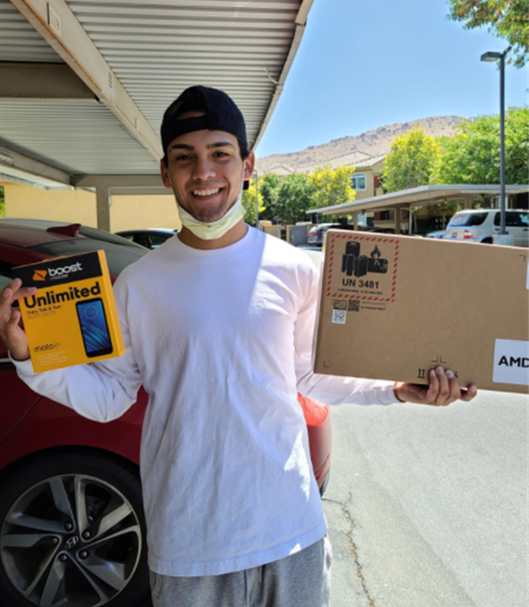By Sara Tiano
 A foster youth who received a free phone through iFoster’s pilot program. Photo courtesy iFoster.
A foster youth who received a free phone through iFoster’s pilot program. Photo courtesy iFoster.
When the pandemic hit California last spring, Yerimera Rodriguez was a young, first-time mom, trying to manage life with a newborn and a double-major’s load of college classes. The screeching shutdown of society and shift to virtual learning threatened to derail the former foster youth. Isolated at home without Wi-Fi, she lost access to both school and support systems essentially overnight.
But then came a lifeline: a smartphone and internet hotspot provided to foster youth across the state by the nonprofit iFoster. The national nonprofit’s free cell phone program has recently been evaluated by state officials with the Public Utilities Commission, which is recommending a $10 million ongoing investment and making the offering a permanent fixture for foster youth in California.
“I’m actually able to finish my schoolwork because of this phone,” 23-year-oldRodriguez said. With the Wi-Fi hotspot it provided, she could connect her laptop to the internet to attend online classes.
Her son Calvin, who turned 1 last month, stayed connected too. The toddler has been able to maintain contact with family members via video chat — critical bonding for Rodriguez, who studies child development and psychology at Los Angeles Trade Tech College.
Rodriguez is among 11,000 current and former foster youth ages 13 through 26 who have received a free phone through iFoster’s program, which comes equipped with a prepaid plan with unlimited minutes and texting, and high-speed data. A May evaluation of the two-year pilot program by the state utility commissiondetermined that the mobile devices had quickly become an “essential resource,” connecting youth with family and friends and supporting their well-being and education throughout the pandemic.
 One of the thousands of current and former foster youth who received a phone through the nonprofit, iFoster. Photo courtesy iFoster.
One of the thousands of current and former foster youth who received a phone through the nonprofit, iFoster. Photo courtesy iFoster.
The Truckee-based nonprofit, with over 60,000 members in 50 states, Guam and Puerto Rico, launched the pilot in November 2019, just months before the coronavirus forced much of life to shift to the virtual world. Though slow to start — sending out 400 phones in the first few months — by March, the group had begun shipping and activating more than 1,500 phones a month.
A 2016 evaluation by University of Southern California researcher Jeremy Goldbach identified a stark “digital divide” between foster youth and their peers: fewer than a quarter of California foster youth surveyed had a computer at home, compared to roughly 90% of youth nationwide.
iFoster’s Kristine Schneller, who manages the $22 million phone distribution program,said while the need was always there, social distancing restrictions imposed during the pandemic gave social workers “a kick in the pants” to get the technology into their clients’ hands.
“Up until now, technology access was viewed as a ‘nice to have,’ but not necessary for foster youth to function in today’s society,” iFoster CEO Serita Cox wrote in a June op-ed published in The Imprint. But the pandemic changed that.
The pilot evaluation by the California Public Utilities Commission released May 6 found that keeping in touch with social workers was among the “numerous benefits” the free phones afforded foster youth, along with access to their lawyers, mentors and telehealth providers. They also made it possible for foster youth to visit virtually with parents and siblings.
Foster youth who have advocated for greater access to free phones also say they provide an added level of safety, ensuring private conversations if they find themselves in abusive homes or other dangerous situations.
To address safety concerns associated with exploring the internet — particularly among a group of young people at higher risk of online dangers like identity theft and trafficking — iFoster offers a self-directed curriculum for participants that describes internet risks and how youth can protect themselves and their personal information.
Amid the past year’s campus closures, nearly 90% of pilot participants surveyed reported relying on their phone and hotspot to attend online classes and do schoolwork. Six months into the shutdowns, iFoster successfully lobbied the California utilities commission for an increase in participants’ data allowances to improve their streaming capacity.
Thestate agency’s recently completedevaluation recommends extending the pilot for at least 14 months to further study how much data foster youth need included in their phone plans. Ultimately, they could become eligible for LifeLine, a state program that provides phones and other communication tech to low-income Californians.
The California Public Utilities Commission will vote on the $10 million proposed pilot extension on June 15.